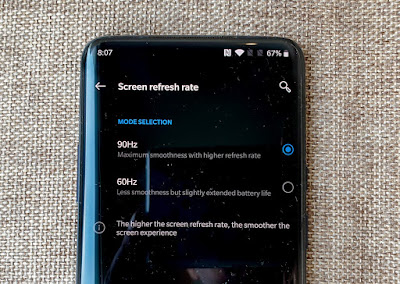Why does the screen refresh rate matter so much on a smartphone?
A refresh rate is the number of times your monitor updates with new images each second. For example, a 60 Hz refresh rate means the display updates 60 times per second. A higher refresh rate results in a smoother picture
It is required in Gaming mobile for higher graphics support and color.
It is required in Gaming mobile for higher graphics support and color.
The term refresh rate, in layman terms, is the count of how many times the screen refreshes its image in one second. It is basically measured in Hz. At present, most smartphone displays have a 60Hz refresh rate, or in other words, even if you are viewing a static image, your display is redrawing the same picture or is pushing the same frame 60 times every second.
At times people tend to get confused between higher refresh rates and higher frame rates (Hz vs FPS). FPS is the count of how many frames are being pushed to the display every second. FPS is related to the content you run on the screen, which might be a video or a game.
So, ideally, if your video has been shot and packaged at 90 frames per second (FPS) and your display has a 90Hz refresh rate, your phone will be able to push all frames.
Similarly, you can play games or videos at 90fps on 90Hz refresh rate panel but not on a display with a lower, say 60Hz, refresh rate.
If you feed 60fps content to a 90Hz screen, the display will either switch to 60Hz or duplicate some frames.
What does a higher refresh rate screen feel like? The impact is subtle yet noticeable and, we’d say, quite addictive. If you are scrolling in App drawer, in your browser, settings menu, or your social media feed, your content will flow up and down smoothly with less friction. Kind of like the difference you’d feel between pushing an ice slab and a wooden slab on a marble floor. Similarly, animations are smoother too.
Higher Refresh Rate displays: Advantages and Disadvantages
Pros
- Noticeably smoother scrolling and animations
- Less eye fatigue
Cons
- Consume more battery
Limitations
Not much content is available to take advantage of 90Hz, so most videos and games push only 60 frames per second. This is also why most high refresh rate phones are programmed to dial down to 60Hz refresh rate when you are watching videos.
Difference Between Touch Refresh Rate and Display Refresh Rate
Touch Refresh Rate means the speed at which the screen can register your touch and respond by starting to render the next frame in an animation.
If the touch refresh rate and the display refresh rate are both clocked at 60Hz, it means the tracking and refreshing coincide, and the animations are rendered one interval later.
However, say, if the touch refresh rate is 120Hz and the display refresh rate is 60Hz, animations will still be snappier and smoother, and your screen would still appear to be more responsive, but the overall experience won’t match the fluidity of having a 120Hz refresh rate screen.
The iPhone Xs and Xs Max, for instance, have a 120Hz touch refresh rate, and the new iPad Pro 2018 has a 120Hz display refresh rate.

No comments:
Post a Comment